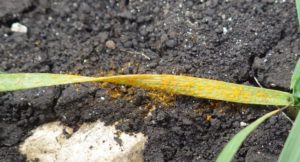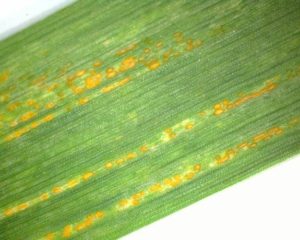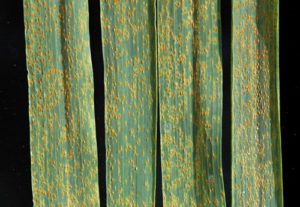By David Drake, John Few, and Tyler Mays – Texas A&M AgriLife Extension Agents – IPM Commerce, Thrall, and Hillsboro, TX
In the past several years heavy outbreaks of rust on seedling wheat, especially stripe rust, have warranted and responded favorably to an early fungicide application. This year the disease is present in high levels in the southern part of the state and fungal spores will be carried by wind to the rest of the plains where continued wet weather could provide for ideal disease conditions.
When scouting seedling wheat fields and deciding on management practices, some important points to consider are:
Host plant resistance is still the best form of protection and fungicide applications to resistant varieties do not result in increased yields or grain test weight when compared with untreated checks.
Seedling rust resistance is genetically different from more mature plant resistance. Published variety resistance ratings are focused on the mature plant or the flag leaf and may not apply to the seedling stage wheat. Observations in research and extension trials have shown that very few of the Hard Red Winter wheat varieties have any seedling resistance to stripe rust, Iba and Gallagher are particularly susceptible. In contrast, most of the Soft Red Winter wheat (SRWW) varieties have seedling resistance to stripe rust. A few SRWW varieties that have shown heavy infestations of seedling stripe rust are: 25R40, 25R50, and USG 3536.
Stripe rust differs from leaf rust. Stripe rust also called yellow rust is most active when temperatures are between 50⁰ and 64⁰ F and have a wet leaf for at least 6 hours. Above 90⁰F new infections do not occur and leaf rust becomes more of a concern. Stripe rust pustules form in lines along the veins of the leaf, hence the “stripe” term. Leaf rust is more red in color and forms many round pustules distributed around the leaf. See Figures 1-3. Stem rust is also different but less commonly seen in U.S. varieties.
A fungicide application to seedling wheat would be warranted when a susceptible variety has active rust pustules throughout the field and yield and weather conditions are expected to be favorable for disease. Fungicides protect expected yield and are not a replacement for regular scouting and timely management. Control of seedling rust is thought to decrease the spore load that will infect the future emerging upper leaves. The latest Texas A&M AgriLife Extension variety ratings for disease resistance can be found at http://varietytesting.tamu.edu in the 2018 wheat variety trial results.
Always read and follow the label directions of crop protection products.

David Drake, Extension Agent-IPM
Hunt County Office
Texas A&M AgriLife Extension Service
Commerce, TX 75429
Phone: 903-468-3295
david.drake@ag.tamu.edu


